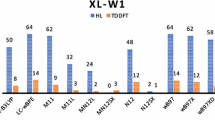Summary
Stereochemistry and tautomerism of stentorin, isostentorin, and fringelit D were investigated using an MM2 derived force field method. For these pigments, the 7,14-dioxo tautomers were derived to be the most stable ones, with a gap of about 50 kJ/mol separating them from the less stable species. The three quinones display propeller and double butterfly conformers. The double butterfly conformers were found to be slightly more stable than the propeller conformers. Compared to hypericin the interconversion barriers between these conformers and between enantiomeric conformers of the same type are lower. They were estimated to be in the order of 40 kJ/mol; thus an isolation of enantiomers is improbable.
Zusammenfassung
Die Stereochemie und Tautomerie von Stentorin, Isostentorin und Fringelit D wurden mit Hilfe einer von MM2 abgeleiteten Kraftfeldmethodik untersucht. Für diese Pigmente wurde abgeleitet, daß die 7,14-Dioxotautomeren am stabilsten sind und daß sie durch eine Energielücke von etwa 50 kJ/Mol von den weniger stabilen Tautomeren getrennt sind. Diese drei Chinone liegen jeweils als Propeller- und Doppelschmetterlings-Konfomere vor, wobei letztere geringfügig stabiler als erstere sind. Verglichen mit Hypericin sind die Interkonversionsbarrieren zwischen diesen Konformeren, wie auch zwischen enantiomeren Konformeren desselben Typs, niederer. Sie wurden zu etwa 40 kJ/Mol abgeschätzt und lassen damit eine Isolierung von Enantiomeren unwahrscheinlich werden.
Similar content being viewed by others
References
Tao N., Orkando M., Hyon J., Gross M., Song P.-S. (1993) J. Am. Chem. Soc.115: 2526
Roth L. (1990) Hypericum-Hypericin, Botanik · Inhaltsstoffe · Wirkung. ecomed verlagsgesellschaft mbH, Landsberg
Blumer M. (1965) Science149: 722; (1962) Geochim. Cosmochim. Acta26: 225
Etzlstorfer C., Falk H., Müller N., Schmitzberger W., Wagner U. (1993) Monatsh. Chem.124: 751
Sprague J. T., Tai J. C., Yuh Y., Allinger N. L., (1987) J. Comp. Chem.8: 581; Liljefors T., Tai J. C., Yuh Y., Allinger N. L. (1987) J. Comp. Chem.8: 1051
Etzlstorfer C., Falk H., Müller N. (1993) Monatsh. Chem.124: 431
Ball & Stick 3.5: Müller N., Falk A. (1993) Cherwell Scientific Publ. Ltd., Oxford, U.K.
Etzlstorfer C., Falk H. (1993) Monatsh. Chem.124: 1031
Author information
Authors and Affiliations
Rights and permissions
About this article
Cite this article
Etzlstorfer, C., Falk, H. Stereochemistry and tautomerism of stentorin, isostentorin, and fringelit D: Force field investigations. Monatsh Chem 125, 955–961 (1994). https://doi.org/10.1007/BF00812710
Received:
Accepted:
Issue Date:
DOI: https://doi.org/10.1007/BF00812710




